|
|
 |
| My Favourite Planet > Blogs > Cheshire Cat Blog > 2013 |
 |
 |
back |
The Cheshire Cat Blog
 |
 |
August 2013 |
 |
| |
 |
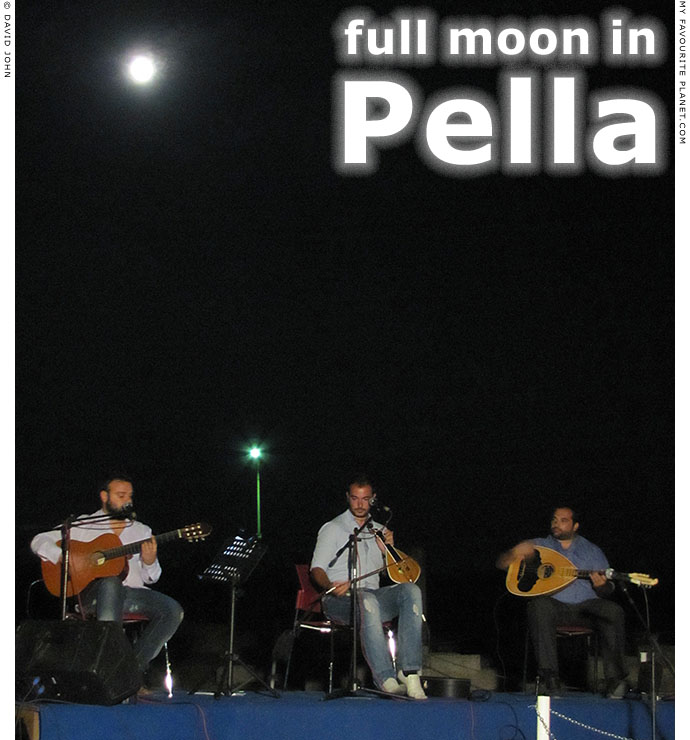
Greek musicians play traditional Cretan music under the full moon at the Pella archaeological site Pella.
The Cheshire Cat returns to Macedonia to revel at the August
Full Moon Concert at the birthplace of Alexander the Great. |
| |
Pella, Macedonia, Greece
Wednesday, 21 August 2013
During a previous visit to Pella last October, Haris Tsougaris, the Director of the Pella Archaeological Museum, told me about the annual August full moon concerts held at the site of the ancient Macedonian capital. This sounded like an enchanting prospect - something definitely not to be missed - and I was determined to try to get there for this year's "Στο φως του αυγουστιάτικου φεγγαριού" (By the light of the August moon).
The only problem was that a few days before the big event I was still busy down in central Greece and everything was taking much longer than scheduled: life in slow motion in the August heat. I was also uncertain about whether the full moon festivities, which have been held at several archaeological sites in Greece since 2011, would still be going ahead as the continuing Greek economic crisis has meant severe budget-slashing and staff shortages at many of the country's sites and museums. I could find no information about full moon events for 2013 on the web, but felt sure that Mr Tsougaris would somehow manage to pull a rabbit out of the hat and put on a show this year. So I made the impulsive decision to head north, still not knowing if I would make it to Pella on time.
Finally arriving at Thessaloniki, I phoned Mr Tsougaris, and was delighted to learn that the party was definitely on.
After 40 minute bus ride, I landed at the modern village of Pella, right next to the the splendid new museum and archaeological site, and had time to visit the museum, take refreshments at a local taverna and a walk around the village before heading towards the site for the full moon fandango.
We will be reporting more fully on the new museum and the archaeological site in the forthcoming update of the My Favourite Planet guide to Pella. But for now, a few brief impressions of the place itself and the event. |
|
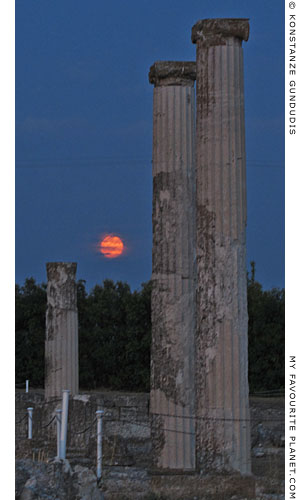
The moon rises red behind the columns
of the peristyle of the "House of Dionysos". |
|
|
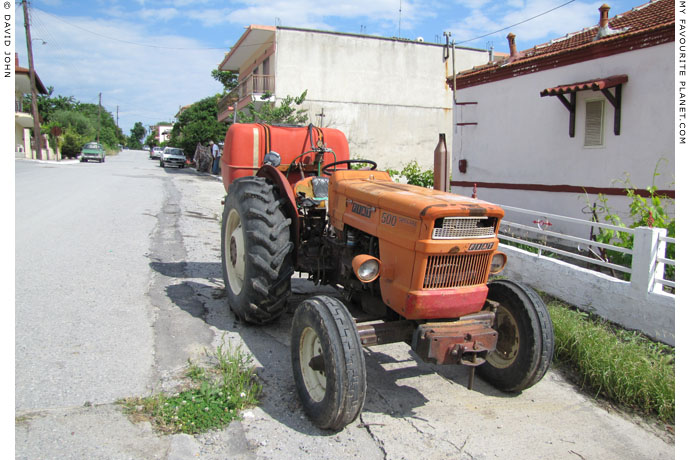
A Fiat 500 Special tractor parked in the farming village of Pella.
|
Modern Pella is a farming village on a wide, fertile plain which stretches from Thessaloniki to the southeast, to the surrounding hills and mountains of Central Macedonia to the north and west. This area has been farmed since prehistory, and even during the brief interval of fame and wealth achieved by ancient Pella during the Classical and Hellenistic periods agriculture provided the backbone of the local economy and culture, as it still does today.
With the help of a relatively mild climate, good water supply and soil, the farmers here manage to produce a variety of crops, including cotton (see photo below). Right about now everybody is busy with the cotton harvest, but by the time I get out towards the fields surrounding Pella it is already early evening, and it seems that most people have gone home to prepare themselves for the evening's entertainment.
Pellans have a strong sense of local history, as can be seen from the large bronze statue of Alexander the Great which stands in the centre of the village, a bust of Euripides (who wrote and produced his last plays here) in front of the Dimarcheion (town hall) and copies of ancient Greek art which adorn houses. They also support the archaeological endeavours here, even though few locals profit from them directly. Most visitors arrive here by tour buses for a brief visit to the museum and site and never set foot in the village or its shops, cafes or restaurants. This is the unfortunate lot of many communities near popular tourist attractions. Personally I find this a pity as there is often much to be learned and enjoyed by spending time in a village like Pella.
Mr Tsougaris would also like to see the village gain more benefit from its proximity to the site. Always thoughtful and enthusiastic, he outlined to me some of the ideas he had come up with towards achieving this. Considering the present economic privations, his ideas are as suitably low-cost as they are novel, although we will not be revealing them here. Some other time, maybe... |
|
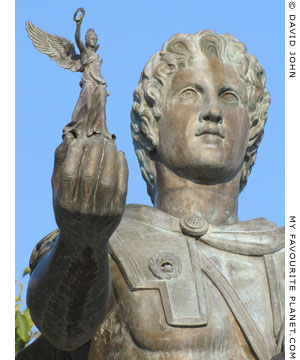
A modern bronze statue of Alexander
the Great in the centre of Pella village.
The Macedonian king holds a Nike
(Victory) standing on an orb.
Sculpture by K. Xyterio (Κ. Χγτηριο)
and M. Gabala (Μ. Γαβαλα), 2002.
See more photos and information
on the Alexander the Great page
of the MFP People section. |
|
|
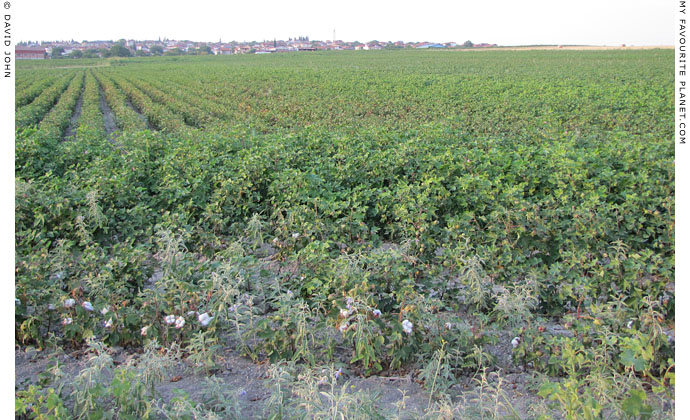
One of the cotton fields around the village of Pella, which can be seen in the background.
|
| By the end of August in Macedonia the hottest days of summer have already passed, the sun sets around 8 pm, and although locals are already thinking about autumn, for northern Europeans average temperatures around 35 degrees Celcius are quite warm enough, thank you very much. We look forward to some relief from the relative cool of the evening and hope for a breeze. |
|
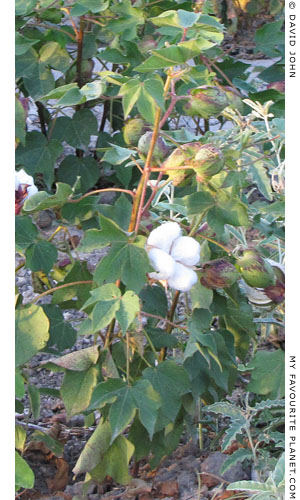
Cotton buds really do grow on trees |
|
| |
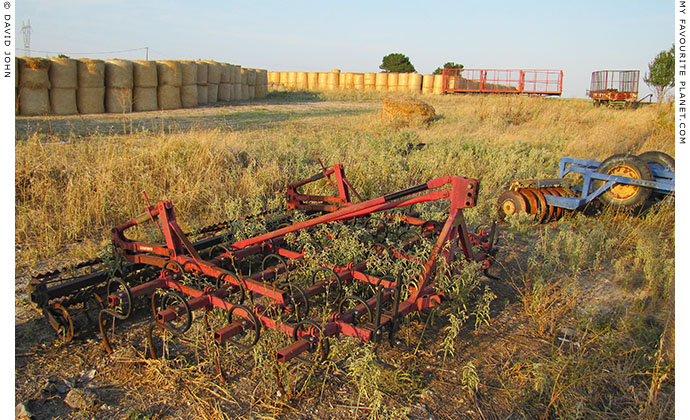
The hay has already been baled... |
| |
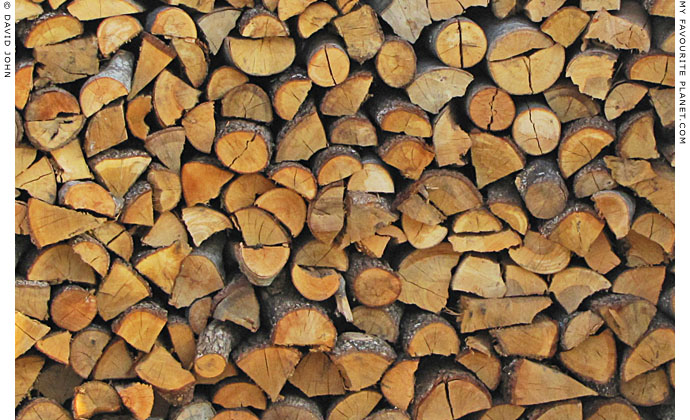
... and the winter wood supply has been chopped and stacked. |
| |

Pella poultry strut their stuff and enjoy the last of the summer sun.
|
Yes, chickens, very nice. But's let's not dawdle here,
we've got a concert to get to. This way, everybody... |
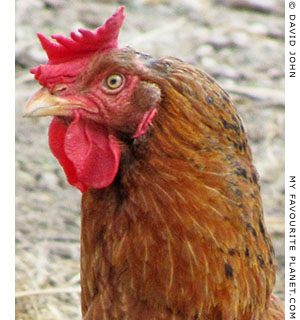
We're free-range, you know. |
| |
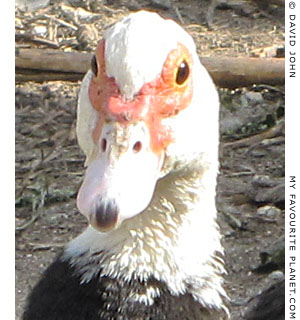
I'm not even a chicken.
What am I doing here? |
| |
|

The old highway leading to the Pella Archaeological site.
Beyond to west, the Voras Mountains north of Giannitsa.
|
The E86 (National Road EO 2), the main highway between Thessaloniki, Giannitsa and Edessa, follows the route of the 2nd century BC Roman trans-Balkan Via Egnatia (Ἐγνατία Ὁδός) which connected the Adriatic port of at Dyrrachium (now Durrës, Albania) with Byzantium (now Istanbul), see History of Stageira & Olympiada part 7. Until a few years ago it ran right through the archaeological site of Pella, which was frustrating for archaeologists and hazardous for visitors trying to cross the busy road which separated the old museum from the entrance to the site.
Fortunately, when improvements for the road were being planned, it was decided to divert the road around 500 metres further south of Pella. The stretch of the old road now ends at the gates of the site, from where another road leads up north to the village and the new museum. It is now used mostly by local traffic and agricultural vehicles, making it much safer and more pleasant to walk or cycle along.
The trees sheltering the site entrance can be seen at the end of the road. We're almost there... |
|
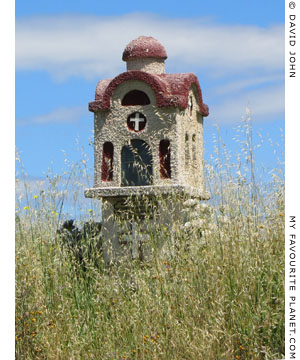
A roadside shrine |
|
|
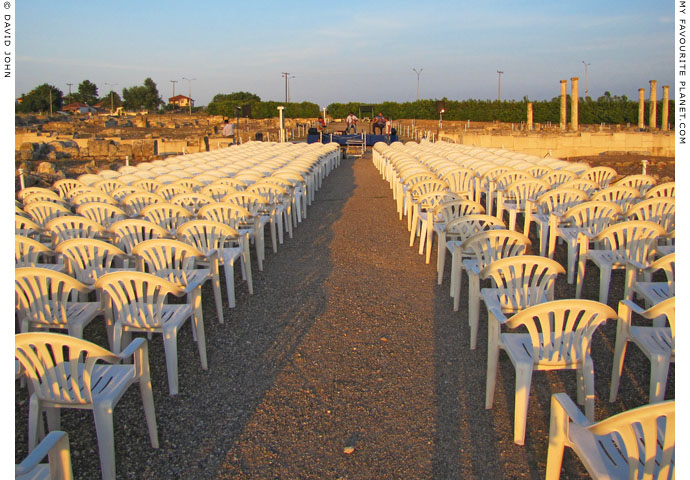
Miles of aisles
|
And finally we are here. The seating for the concert was set up along the wide ancient street between "the House of the Abduction of Helen" and "the House of Dionysos" so that the audience could enjoy the view of the moon rising behind the stage and the columns of the courtyard of the House of Dionysos. Perhaps it was the god of revelry himself who organized for the moon to rise exactly in the right place.
The concert was organized by the hard-working staff of the museum and archaeological site, with the help and support of the local community and sponsorship from the Pella Municipal Benefit Enterprise for Culture and Sport (Δημοτικής Κοινωφελούς Επιχείρησης Πολιτισμού και Αθλητισμού Πέλλας).
The sun was just setting behind us, and the musicians were already tuning up on the stage. I have seldom seen a band setting up so quickly and efficiently, and the sound engineeer wired everything up speedily and without fuss. The sound from two small speakers, set either side of the stage, was surprisingly excellent and clearly audible from the back rows. (Unfortunately, I forgot to note the brand of the speakers for all you technically-minded readers.) |
|
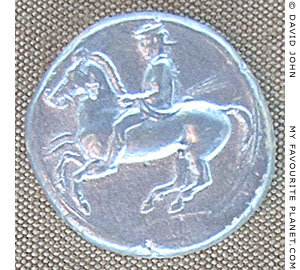
Silver didrachm minted by King Archelaos
(ruled 413-399 BC) who moved the capital
of Macedonia from Aigai (today Vergina) to
Pella around the end of the 5th century BC. | |
| |
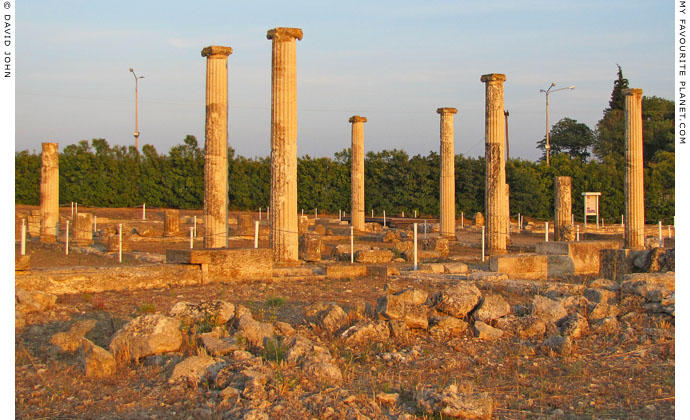
The restored colonnade of the peristyle courtyard of "the House of Dionysos".
|
| "The House of Dionysos" is named after the large pebble floor mosaic of Dionysos riding a panther discovered by archaeologists in one of its symposium halls. It is the largest private house found in Pella so far. Covering an area of 3,160 square metres, the once magnificently appointed house takes up an entire block of the ancient city's grid system. The Ionic columns in the photo above surround the north courtyard of the house, while the southern courtyard had Doric columns. |
|
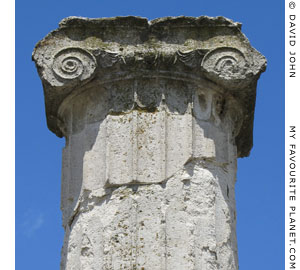
One of the Ionic column capitals
of "the House of Dionysos". |
|
|
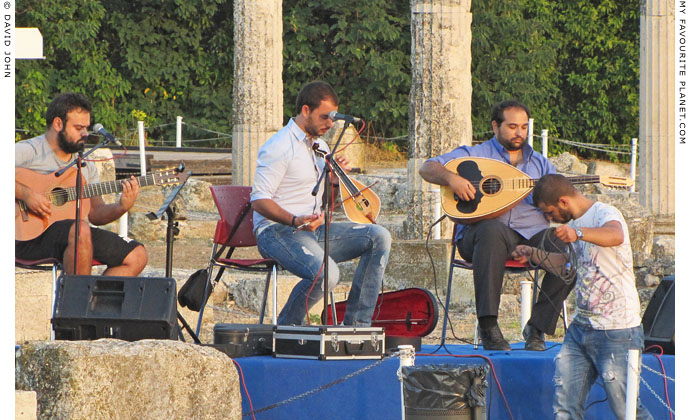
Cretan lyra player George Sfakianakis (Γιώργος Σφακιανάκης, centre) and his band tune up
while the sound engineer lays an Ariadne's thread of cables in record time. |
| |
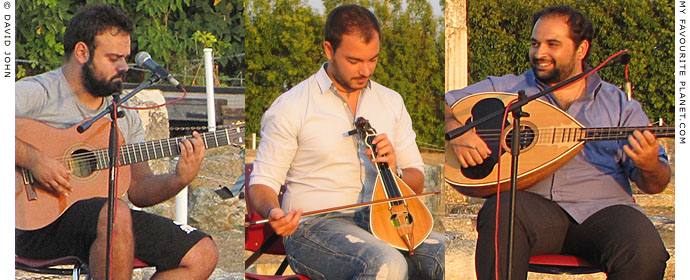
Introducing George Sfakianakis and his band ... |
|
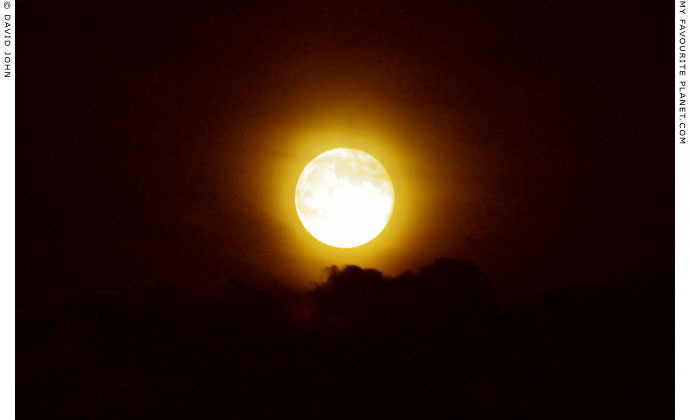
The August moon makes it's appearance.
"The glow and beauty of the stars are nothing near the splendid moon
When in her roundness she burns silver about the world . . ."
From a fragment of a poem by Sappho (circa 615 - 562 BC).
|
| |
As the sky darkened and the moon rose above Pella over 600 people of all ages turned up to enjoy the concert. Many of them were local people, mostly from Pella village, including the mayor. The atmosphere was relaxed and friendly, and it seemed that everybody knew everybody. After greetings, gossip and refreshments provided by a local kantina van and a popcorn stand set up in front of the entrance to the archaeological site, they walked past the remains of ancient houses and floor mosaics to the concert area.
The moon was up, the audience sat down, and Haris Tsougaris stepped up to the microphone to welcome everyone. A few words of greetings and thanks and the show began.
The concert consisted of a set of traditional Cretan music and more modern songs in traditional style, led by the lyra and singing of George Sfakianakis, accompanied by bouzouki and guitar, with the guitar player also singing on some of the numbers. (As soon as the band send me more information about themselves and their music I will post it here.) The rhythmic pace and mood of the music varied from strident and dramatic to more melodic and romantic, and brought the exciting sounds of the wild Cretan mountains to the gentler Macedonian plain. The effect, at least for this member of the audience, was very uplifting and captivating. Memories of many merry evenings in Crete could not be avoided, so I let them flow over. A very special evening, and good time was had by all.
After the concert I joined Haris Tsougaris and the musicians in a local taverna where an excellent supper of home-cooked goodies had been prepared. George told me that he had grown up with this music and learned the lyra from his father. Once again I was impressed that such traditions are being continued in Greece in the age of mp3 pop (see also the article about a Macedonian folk dance troupe, The Cheshire Cat Blog, May 2012). |
|
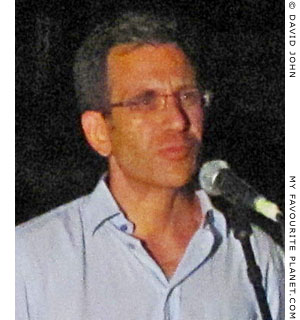
Haris Tsougaris, archaeologist and director
of Pella Museum, welcomes the audience
to the 2013 Pella August full moon concert.
Pella Museum now has its own website:
www.pella-museum.gr
So far, it is all in Greek, but if you are
using a browser such as Google Chrome
it should be able to provide a decent
translation into English, German
and other languages. |
|
|
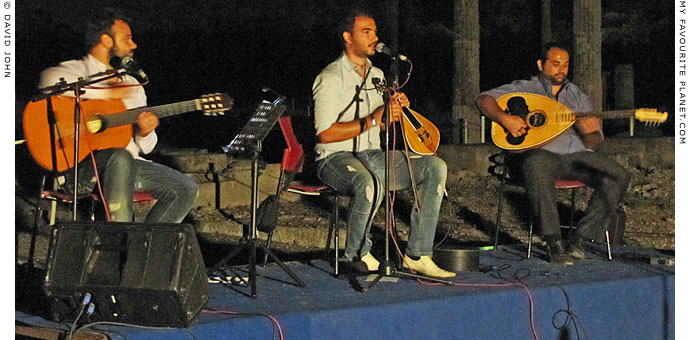 |
 |
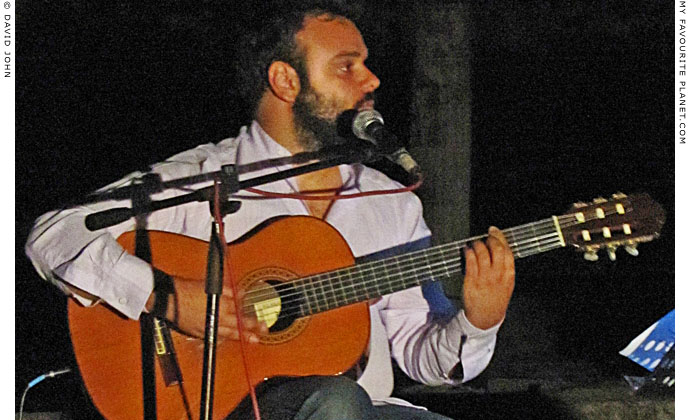 |
 |
 |
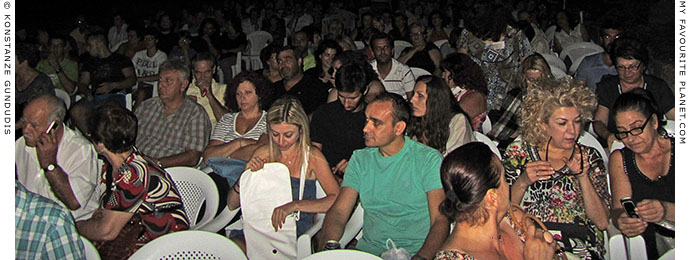
During the intermission, some of the audience went off for refreshments
while others made calls on their cell phones, checked their text messages
and compared photos. Thoroughly modern Macedonians. |
| |
Photos and articles copyright © David John 2012-2013
Additional photos © Konstanze Gundudis 2013
Many thanks to Haris Tsougaris,
the staff of the Pella museum and archaeological site
and the people of Pella.

The Cheshire Cat Blog at My Favourite Planet Blogs
We welcome considerate responses to these articles
and all other content on My Favourite Planet.
Please get in contact.
The photos on this page are copyright protected.
Please do not use them without permission.
If you wish to use any of the photos for your website,
blog, project or publication, please get in contact.
Higher resolution versions are available on request. |

Why did I cross that road? |
|
 |
Visit the My Favourite Planet Group on Facebook.
Join the group, write a message or comment,
post photos and videos, start a discussion... |
|
Views of blog authors do not necessarily reflect those of the publishers
or anyone else at, on or in the vicinity of My Favourite Planet. |
 |
| |
|
|
| |
| |
 |
| |
 |
| |
 |
| |
 |
| |
 |
| |
 |
| |
George Alvanos
rooms
in Kavala's historic Panagia District
Anthemiou 35,
Kavala, Greece
kavalarooms.gr |
| |
| |
Olive Garden Restaurant
Kastellorizo,
Greece +30 22460 49 109
kastellorizo.de |
| |
| |
Papoutsis
Travel Agency
Kastellorizo,
Greece +30 22460 49 286
greeklodgings.gr |
| |
| |
|